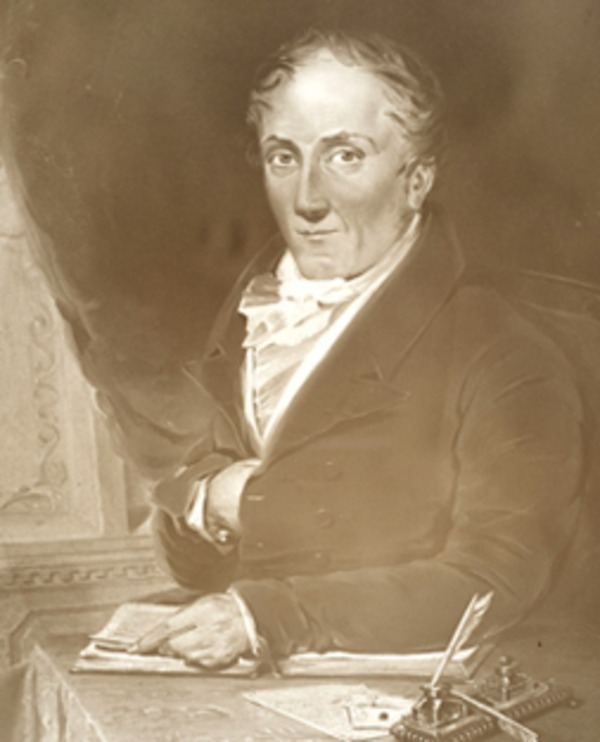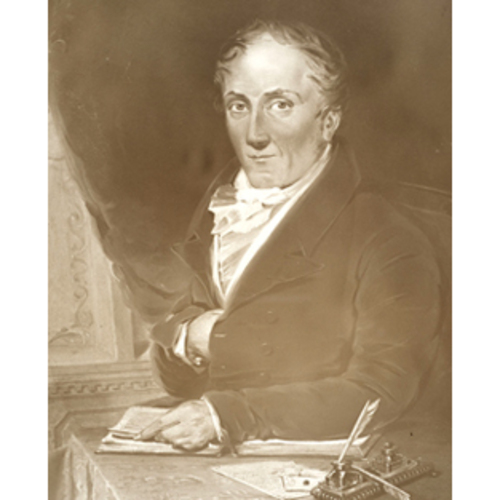
Source: Courtesy of Wikimedia Commons
MACAULAY, JAMES, doctor, army officer, jp, and office holder; b. 1759 in Scotland; m. first 20 Nov. 1790 Elizabeth Tuck Hayter (d. 1809), and they had four sons and four daughters; m. secondly 10 Nov. 1817 Rachel Crookshank in York (Toronto); d. there 1 Jan. 1822.
James Macaulay joined the Queen’s Rangers as surgeon’s mate in 1779 and served with the regiment throughout the American revolution. He transferred to the 33rd Foot in 1785 and four years later was appointed surgeon of the New South Wales Regiment on the recommendation of his former commanding officer, John Graves Simcoe*. When Simcoe began planning his staff for the loyalist province of which he was to become lieutenant governor, he did not forget his “old Surgeon,” whom he described as “a young man attached to his Profession, and of that docile, patient, and industrious turn . . . that will willingly direct itself to any pursuit. “Macaulay was appointed surgeon on 1 Sept. 1791 and the following year accompanied Simcoe to Upper Canada.
Macaulay and his wife, a naval officer’s daughter who had become close friends with Mrs Simcoe [Gwillim*], settled at Newark (Niagara-on-the-Lake), the provincial capital, and soon were prominent members of the local society. In 1795 the couple were among the victims of a scurrilous squib, purportedly written by the provincial secretary, William Jarvis*. By 1796 the family had moved to the new seat of government at York where Macaulay had been granted a town lot. An assiduous collector of land grants for himself and his family, before 1800 he had received 1,600 acres as part of his military allotment, a town lot in York and 1,200 acres for his wife, and 600 acres for each of his four children. But his most important acquisition was a 100-acre park lot north of the town along Lot (Queen) Street west of Yonge Street; this area, on which he would later begin to lay out lots, became known as Macaulay Town and was absorbed into the city of Toronto in 1834.
At York, Macaulay took an active part in local affairs: he was appointed a justice of the peace in 1800, served as a commissioner to oversee the improvement of Yonge Street the following year, and with Chief Justice Henry Allcock*, the Reverend George Okill Stuart*, and others was on a committee planning the building of an Anglican church in 1803. That year, however, Macaulay was made senior hospital officer in the Canadas with the rank of surgeon to the forces, a post which required him to reside in Quebec. He managed to postpone his departure until September 1805, when he left York with “the prayers of a grateful community” and a “testimonial of regret” signed by its leading citizens.
Macaulay remained in charge of the medical department of Upper and Lower Canada until 1808 when he lost the post to William Somerville, the deputy inspector of hospitals on Governor Sir James Henry Craig*’s staff. In 1810 Macaulay petitioned to be appointed deputy inspector of hospitals but was judged unqualified for the position. He was named one of Lower Canada’s medical examiners in December of that year along with Somerville, George Longmore*, and James Fisher and, after Somerville returned to England in 1811, again served as senior hospital officer. During the War of 1812 Macaulay helped to plan and establish military hospitals in Lower and Upper Canada. In May 1813 he served with Lieutenant-General Sir George Prevost* at the attack on Sackets Harbor, N.Y., and, following his appointment that July as deputy inspector of hospitals, was with Major-General Francis de Rottenburg on the Niagara peninsula. He was serving there at the end of the war and subsequently was stationed at Kingston until placed on half pay in February 1817.
That spring Macaulay returned to York, petitioned for the 1,000 acres to which he was entitled by his war services, and settled back into the medical circles of the town and the life of its local gentry. He served on the first Medical Board of Upper Canada with Christopher Widmer*, Grant Powell*, and William Lyons and acted as its senior medical officer from January 1819 until his death three years later. With James Baby, Peter Robinson*, and others, he was appointed to a commission formed in 1819 to deal with estates forfeited during the War of 1812, and he joined with other members of York’s élite, including William Allan*, Thomas Ridout, and William Warren Baldwin*, in promoting the bank which was to be chartered as the Bank of Upper Canada.
James Macaulay’s military career and land grants had brought him a comfortable existence and on his death he was able to leave to his children various land holdings and to his widow £2,000 in Bank of England stock. By marriage the Macaulays were related to some of the most prominent families in Upper Canada. James’s second wife was a sister of George Crookshank*, and his four daughters married Christopher Alexander Hagerman*, John William Gamble*, Peter Diehl, and John Solomon Cartwright* respectively. His eldest son, John Simcoe Macaulay*, was a captain in the Royal Engineers and a legislative councillor in Upper Canada from 1839 to 1841. Another son, James Buchanan Macaulay*, became chief justice of the Upper Canadian Court of Common Pleas.
Academy of Medicine (Toronto), ms 137. AO, MU 1095, Macaulay family. PAC, MG 23, H1, 3, vol.2: 38, 53–54, 77; RG 1, L1, 22: 238, 323; 25: 19; L3, 323A: Mc Misc., 1788–95/5; 328A: M2/258; 330: M4/121; 330A: M4/241; 333: M8/10; RG 5, B9, 61, 16 March 1819; RG 8, I (C ser.), 289: 12, 55–59, 63, 72, 87; 290; 299: 14, 21, 29; 680: 36, 236; 1015: 105; 1120: 205, 292; 1168: 33; 1171: 75; 1203 1/2J: 13; 1218; 1709: 99; 1865: 93; RG 68, General index, 1651–1841. PRO, T 28/9, 24 Oct. 1811 (transcript at PAC). Corr. of Lieut. Governor Simcoe (Cruikshank). “Grants of crown lands in U.C.,” AO Report, 1929: 49, 55, 76, 156, 159. Gwillim, Diary of Mrs. Simcoe (Robertson; 1911). “The probated wills of persons prominent in the public affairs of early Upper Canada: second collection,” ed. A. F. Hunter, OH, 24 (1927): 402–6. Town of York, 1793–1815 (Firth). “U.C. land book B,” AO Report, 1930: 104. “U.C. land book C,” AO Report, 1930: 141, 150; 1931: 18, 57. Chadwick, Ontarian families. Commissioned officers in the medical services of the British army, 1660–1960, comp. Alfred Peterkin et al. (2v., London, 1968), 1: 66. William Canniff, The medical profession in Upper Canada, 1783–1850 . . . (Toronto, 1894; repr. 1980). Robertson’s landmarks of Toronto, 1: 177; 6: 326. F. N. G. Starr, “The passing of the surgeon,” Canadian Practitioner and Rev. (Toronto), 26 (1901): 657–60.
Cite This Article
Geoffrey Bilson, “MACAULAY, JAMES,” in Dictionary of Canadian Biography, vol. 6, University of Toronto/Université Laval, 2003–, accessed December 19, 2025, https://www.biographi.ca/en/bio/macaulay_james_6E.html.
The citation above shows the format for footnotes and endnotes according to the Chicago manual of style (16th edition). Information to be used in other citation formats:
| Permalink: | https://www.biographi.ca/en/bio/macaulay_james_6E.html |
| Author of Article: | Geoffrey Bilson |
| Title of Article: | MACAULAY, JAMES |
| Publication Name: | Dictionary of Canadian Biography, vol. 6 |
| Publisher: | University of Toronto/Université Laval |
| Year of publication: | 1987 |
| Year of revision: | 1987 |
| Access Date: | December 19, 2025 |



